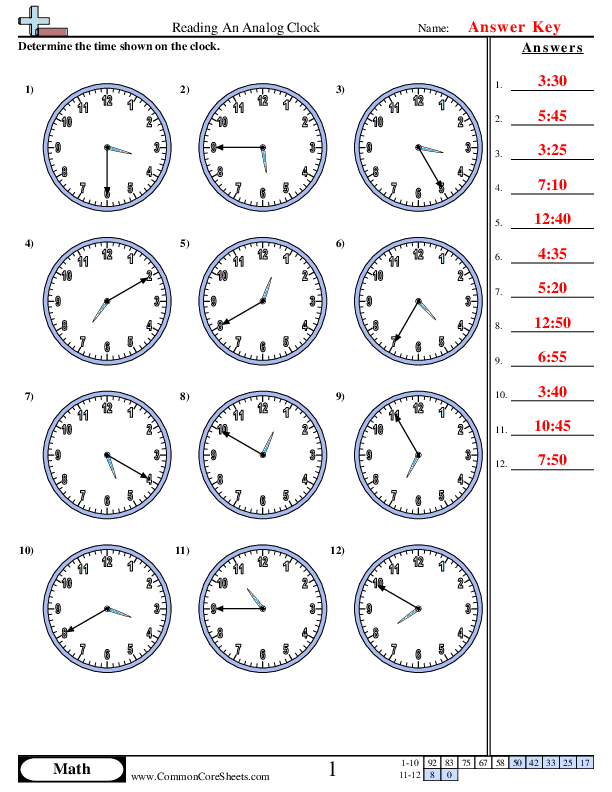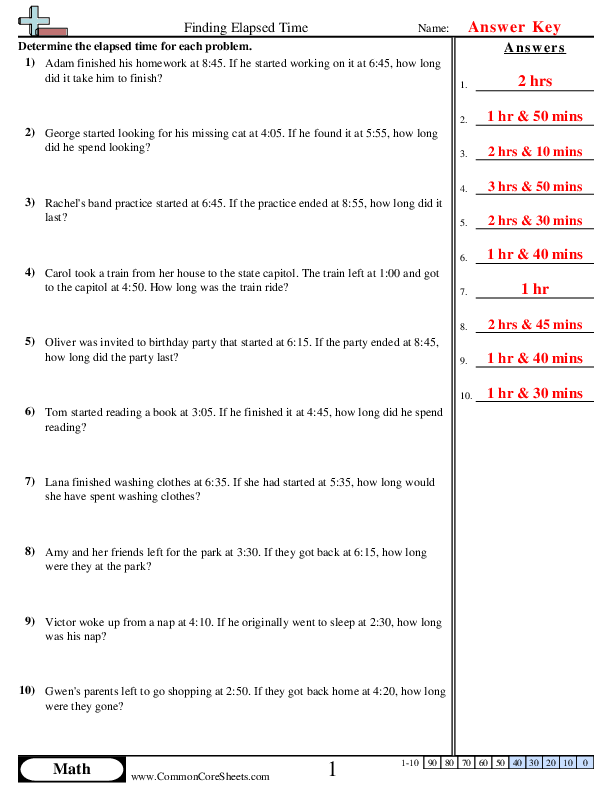Are you looking for the best time worksheets on the internet? Look no further! Our free time worksheets are perfect for teaching students to read a clock, calculate elapsed time, solve start and ending times, and tackle word problems. Our interactive worksheets make it easy for students to learn important concepts related to telling time and understanding intervals between two points in time. With our engaging activities, your students can quickly and accurately practice all of the skills related to telling time. No more wasting "time" looking for worksheets, get your students learning with our top-notch time worksheets today!
Browse Sheets By Problem Type
×
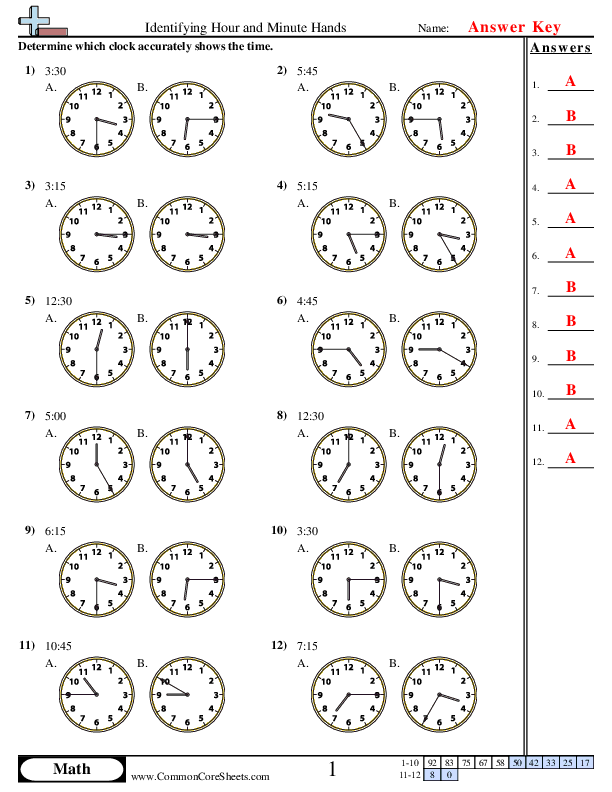
Identifying Hour and Minute Hands


×
Description:
"This worksheet is designed to enhance children's math skills by identifying hour and minute hands. It features 12 engaging problems involving various time-readings, conducive to grasping fundamental time concepts. This worksheet can be easily customized for individual learning pace and goals, transformed into flashcards for efficient memorization or utilized in distance learning platforms. An ideal tool to make learning about time interactive and fun."

×
Student Goals:
Time UnderstandingAfter completing the worksheet, the students will have a solid understanding of how an analog clock works. They will be able to tell the difference between the hour and minute hands and how to correspond them to the right numerals on the clock face. This will aid them in their daily life, allowing them to accurately keep track of time.Math CompetencyThis worksheet focuses on enhancing mathematical abilities in terms of time. By the end of it, learners will be proficient in understanding various intervals of time - full hours, half hours, quarter hours, etc. Moreover, this basic understanding will prove critical when progressing to more advanced math lessons involving calculations with time.Problem-Solving SkillsThrough the worksheet, students will enhance their problem-solving abilities. Presented with different scenarios, they will discern the exact time being displayed on an analog clock. As such, it improves overall cognitive skills by fostering decision-making capabilities and enhancing attention to detail.Application of KnowledgeBy conducting this exercise, the students will be well-equipped to apply their learned knowledge practically. As they become proficient in time understanding, they can effortlessly read time off analog clocks around them – in school, at home, or in public places. This practical applicability makes their learning robust and relevant.Preparation for Advanced LearningThe lessons in this worksheet will act as a stepping stone towards more advanced learning. The fundamental understanding of time will further ease their learning process when they start dealing with more complex mathematical problems linked with elapsed time, time zones, etc.Building ConfidenceFinally, mastering the understanding of time builds a sense of confidence in children. They feel more assured of their learning and become more enthusiastic about learning other concepts. This newfound confidence is beneficial for their overall academic journey – stimulating curiosity, enhancing focus, and encouraging a proactive learning attitude.



Reading a Clock (Half Hour Increments)
1md3


×
Description:
"This worksheet is designed to enhance children's understanding of reading an analog clock. With a total of 12 math-related problems, the exercises involve conceptualization of the traditional time-telling system. This flexible resource is customizable to meet various learning needs, and can be converted into flashcards for an engaging learning experience. It's also suitable for distance learning, facilitating seamless accessibility and intuitive learning for students wherever they are."

×
Student Goals:
Understanding Time ConceptsAfter successfully completing this worksheet, students should have a solid understanding of analog clock reading. They should be familiar with the positions of the hour and minute hand on a clock face and be able to correlate these positions to specific times. They will also get to understand the concept of elapsing time by interpreting the movement of the clock hands.Practical ApplicationBeyond theory, students will be able to apply what they have learned in this mathematical exercise to real-life situations. The ability to tell time underpins many aspects of daily life, from being punctual for appointments to knowing when to perform daily tasks. Consequently, they will be able to manage their time properly and effectively, strengthening their overall time management skills.Problem SolvingBy practicing these analog clock problems, students will sharpen their problem-solving skills. They will learn to interpret the information provided on the clock and translate that into understandable time formats. By addressing different problems, they will also improve their analytical thinking abilities, learning how to approach and solve varying problems in time-related exercises.Boosting ConfidenceSolving analog clock reading problems can sometimes be challenging, but once students are able to easily solve these problems, it will foster confidence in their mathematical abilities. Any hesitation or nervousness about reading analog clocks would have been addressed and overcome, making them more comfortable with time-telling tasks.Numeracy SkillsThe worksheet will contribute greatly to enhancing students' overall numeracy skills. It will help them improve their number recognition as well as their mental arithmetic, since time-telling often involves a good grasp of numbers and calculations. Additionally, it will build their foundational knowledge for more complex math topics and operations.Fostering IndependenceLastly, this worksheet will foster a sense of independence and self-reliance in the students. As they become adept at telling time, they'll need to rely less on digital devices and others to organize their day or know the time. This is a vital skill that will help them in becoming more self-sufficient and capable, enhancing not only their academic competency but their life skills as well.



Matching Clocks (Half Hour Increments)
1md3


×
Description:
"This worksheet is designed to reinforce children's understanding of time. Titled 'Matching Clocks,' it offers 16 math problems that challenge students to pair time expressions with corresponding analog clock faces. With its adaptable format, it can be customized to fit varying curricula, converted into interactive flashcards for hands-on learning or implemented in distance education programs to support academic continuity during remote learning situations."

×
Student Goals:
Enhanced Time UnderstandingPost completion of 'Matching Clocks', students will exhibit an improved understanding of how time works. Reading analog clocks will become second nature to them. Converting the analog time to digital becomes easier and errors are minimized. They understand all 12 hours of the clock and how to distinguish 'AM' from 'PM'.Improved Arithmetic SkillsAs this worksheet involves a lot of counting, addition and subtraction, students will have a greater handle on their basic arithmetic abilities. The repetitive practice will instill in them the know-how of quickly calculating time differences.Enhanced Analytical ThinkingThe matching process requires a good deal of logic and rational thought. Students will need to engage their analytical thinking capabilities to correctly pair the clocks with their corresponding times. This repeated exercise over 16 problems augments their analytical capabilities.Develop Time Management SkillsIn real-time situations, the ability to read a clock is directly linked with one's time management skills. By being able to calculate the time and time differences, students can learn to manage their schedule and activities better.Strengthened Problem-Solving AbilitiesThe worksheet equips students with better problem-solving abilities. They need to figure out the correct match for each clock from multiple options, which helps in enhancing their decision-making and problem-solving skills.Increased Accuracy and SpeedThrough repetitive practice of this worksheet, students will get more precise and faster in matching times. The speed and accuracy gained will prove beneficial for them not only in solving academic math problems but also in processing time in day-to-day life.Boosted ConfidenceUpon successfully completing the worksheet, students should feel a sense of achievement. This success can provide a vital confidence boost, stimulating them to take on more challenging math problems and tasks.Greater Academic PerformanceMastering over time reading improves the students' overall math ability. This improved ability reflects positively not only in their math grades but also contributes broadly in other subjects requiring time management or time-estimation tasks.


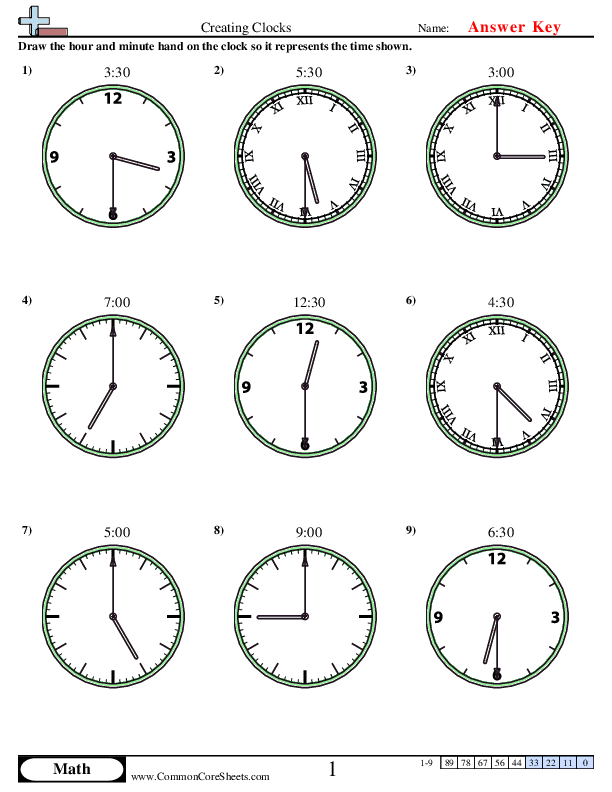
Creating Clocks (Half Hour Increments)
1md3


×
Description:
"This worksheet is designed to help children master the concept of time through the engaging activity of creating clocks. It includes 9 math problems that each present a different time of day. The worksheet offers flexibility for all learning styles and environments—it can be customized to meet individual student needs, converted into flash cards for hands-on learning, or used in distance learning scenarios. An excellent resource for developing essential math skills in a fun, intuitive way."

×
Student Goals:
Understanding Clock FacesAfter completing the worksheet, students should acquire a clear understanding of how traditional clock faces work. Familiarity with the relationship between the short and long arms of the clock and how they denote hours and minutes will allow for error-free interpretation of the time. Through visual recognition of the difference between half-past and o’clock times, they can better understand the concept of time passage.Building Time Telling SkillsAdeptness in telling time on both analog and digital clocks is an essential milestone in children's mathematical learning. By completing the problems provided, they should develop a proficiency in translating time from paper to an actual clock. With improved skill levels, students should not only tell time accurately but also be able to make reasonable estimates about the duration of various events and activities.Enhancing Problem-Solving CapabilitiesUnderstanding the placement and movement of the clock hands enhances children's problem-solving ability. When given a specific time, they should be able to determine the position of each hand on the clock independently. These exercises train children's minds to think logically and solve problems, skills that generalize beyond this specific task.Developing Time Management AwarenessBeing able to tell time accurately is the first step to developing beneficial skills such as time management. As students understand time's passage, they also become aware of life's rhythms and the need for planning and scheduling. Upon completion, students should demonstrate an emerging appreciation for timely task completion.Boosting Math ConfidenceSuccessfully solving time-related problems boost students' confidence in their mathematical abilities. Each correct answer they arrive at, fosters a can-do attitude towards math and instills belief in their quantitative skills. This practice work should help them transition from guided support to independent problem solving in various mathematical contexts, hence encouraging continuous mathematical exploration.


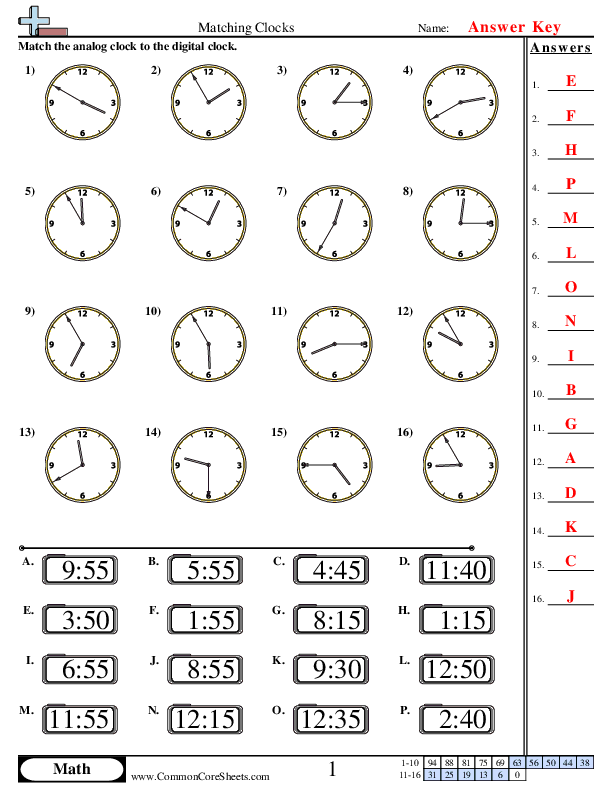
Matching Clocks (5 Minute Increments)
2md7


×
Description:
"This worksheet is designed to enhance children's math skills through 16 engaging 'Matching Clocks' problems. It promotes concepts of time-telling and clock reading in an interactive manner. The worksheet is adaptable to custom needs and can be converted into flashcards for simplified teaching. Perfect for distance learning, it creates an absorbing educational environment for children."

×
Student Goals:
Develop Time-Telling SkillsAfter completing the 'Matching Clocks' worksheet, students should have further developed their ability to accurately read clocks, both digital and analog. They would have practiced recognizing different times and matching them correctly. The understanding of the concept of time, hours, minutes and seconds will be stronger.Improve Problem Solving and Critical ThinkingThe completion of this worksheet would effectively improve the students' problem-solving and critical-thinking abilities. This is achieved as they have to figure out the correct time and match them accordingly. Their analytical skills will be sharpened, and they should be able to use these skills in other aspects of their learning.Boost Confidence in MathematicsAccomplishing this worksheet can also help instill confidence in students' math skills. By successfully solving the problems, they get reassurance in their ability to undertake mathematical tasks and challenges. This confidence can significantly improve their overall performance in the broader subject of mathematics.Gain Practical Real-World SkillTime-telling is a practical real-world skill. Finishing this worksheet means the students have taken one more step in understanding the daily contexts where time interpretation is required - like reading a bus schedule or planning their day. This practice thus brings abstract mathematical concepts into tangible daily life usage.Enhance Accuracy and SpeedWith the repetitious nature of the problems in the worksheet, students will get plenty of practice to improve their speed and accuracy in telling the time. It thus prepares them to perform time-related tasks promptly and efficiently in timed settings.Assimilate Persistent Learning HabitsFinally, the task of completing this worksheet will help students cultivate a habit of persistence. They would learn the importance of regular practice in mastering a particular skill, in this case, time telling, which would be a valuable takeaway for mastering other subjects and skills.


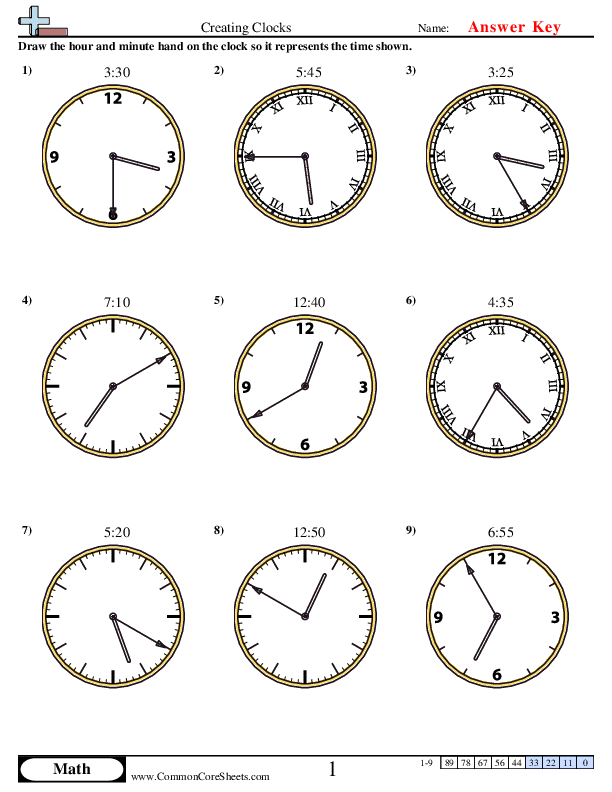
Creating Clocks (5 Minute Increments)
2md7


×
Description:
"This worksheet is designed to enhance children's understanding of time through an engaging 'Creating Clocks' activity. It includes 9 math problems aimed at helping students decipher different time formats. Conveniently adaptable, this worksheet can be customized according to the child's learning pace, converted into flashcards for interactive learning, or utilized in distance-learning settings."

×
Student Goals:
Understanding of the Concept of TimeStudents should develop a thorough understanding of the concept of time after completing the worksheet. They should be able to read, understand, and distinguish the different times given such as hours, minutes, and seconds. They will have an improved ability to tell time, understand the concept of a day, and how it is divided into hours and minutes.Enhancement of Math SkillsBy working on this worksheet, students will enhance their math skills, particularly in the area of telling time. They will learn and practice how to convert time from one format to another. They will also be able to understand the relationship between hours, minutes, and seconds and use this knowledge to solve problems.Improvement in Analytical SkillsThe worksheet is designed to improve students' analytical skills. They will have to analyze the problems given and apply their learned knowledge to solve them. It will enhance their logical reasoning and problem-solving capabilities which are fundamental skills for grasping more complex mathematical concepts in the future.Time Management SkillsThis worksheet aims at instilling the concept of time management in the minds of students from an early stage. They should begin to understand the value of time and how it is essential in planning daily activities. Awareness of time can contribute to better planning and organization of their tasks in the future.Strengthening Concentration and Attention to DetailContinual practice of such time-related problems will lead to an increase in concentration levels and attention to detail in students. They will improve their capability to focus on tasks at hand and pay close attention to minute details key to solving problems correctly.Building ConfidenceSuccessfully solving problems in the worksheet will build students' confidence in their mathematical skills and their ability to understand and work with time. This confidence can translate into other areas of their academics and life, creating a positive effect on their overall learning journey.


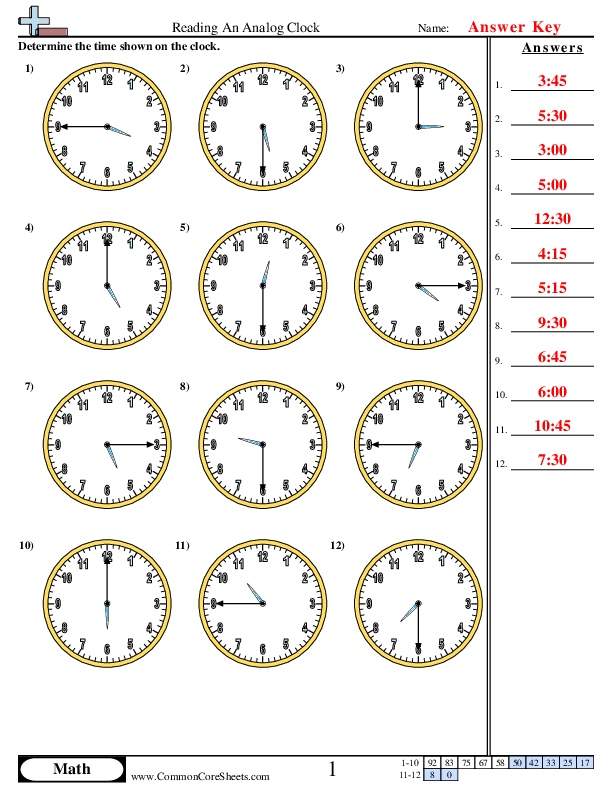
Reading An Analog Clock (15 minute increments)
2md7


×
Description:
"This worksheet is designed to enhance children's mathematical abilities by teaching them to read an analog clock. It features 12 meticulously crafted problems, aimed at reinforcing time-telling skills in a lively and engaging manner. Perfect for distance learning, the material can be effortlessly customized to suit individual needs, and can even be transformed into interactive flash cards for more hands-on learning experiences."

×
Student Goals:
Understanding Time ConceptsAfter completing this worksheet, students should have a foundational understanding of how to read an analog clock. They would have developed skills in identifying the positions of the hour and minute hands and interpreting what each hand's position on the clock face signifies. This helps young learners to gain a basic understanding of the concept of time, an important life skill.Enhancements in Problem-Solving AbilitiesThis worksheet should also encourage improvement in problem-solving skills. Each question serves as a mini problem that requires students to apply their knowledge in a practical way. With continuous practice, they can enhance their logical reasoning and critical thinking abilities which helps them in the longer run in various areas of life.Integration of Knowledge Into Real LifeUpon completion of this worksheet, learners should also be able to translate the knowledge they've gained into real-world situations. They can use these learned skills to tell the time on analog clocks they encounter in everyday life or during math or science concepts that involves measurements or tracking of time.Increased Confidence in MathLearning to read an analog clock and solving related problems can increase students' confidence in their math skills. As they successfully navigate through each problem, they can gain assurance that they are capable of understanding and solving math concepts. This increased confidence can also bolster their enthusiasm for the subject and promote a greater willingness to tackle more challenging math problems in the future.Augmentation of Attention to DetailFinally, this worksheet can help students acquire an attention to detail. Reading an analog clock requires focus on minute features, such as the position of the clock hands. This sharpens their observational skills, promoting an overall enhancement of their attention to detail, a crucial cognitive skill that aids them in various academic disciplines.


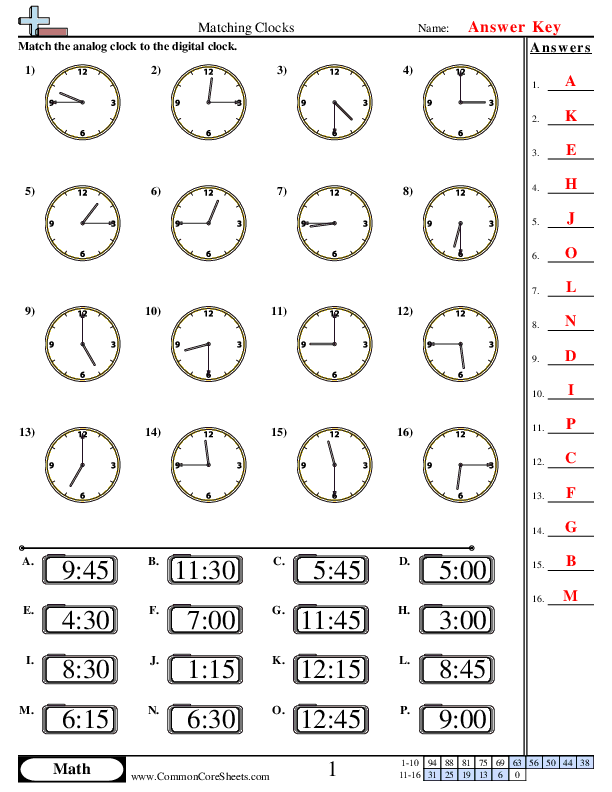
Matching Clocks (15 minute increments)
2md7


×
Description:
"This worksheet is designed to help children grasp the concept of time. Titled 'Matching Clocks', it provides 16 unique math problems that enhance clock-reading skills. Versatile and adaptable, it can be customized to suit individual learner's needs or even be converted into flashcards. Ideal for distance learning, this worksheet is a practical asset for mastering basic math skills in an engaging and interactive way."

×
Student Goals:
Time ReadingUpon completing the 'Matching Clocks' worksheet, students would have honed their skills in reading the time correctly. Whether it's an analogue or a digital clock, they will learn to interpret time accurately, a life skill that stays relevant throughout their lives.Enhanced Math SkillsWorking with time involves complex thinking and calculation skills. Students will learn to apply mathematical operations to determine the difference between times and understand the concept of elapsed time. This exercise will not only enhance their mathematical abilities but also cultivate analytical thinking skills.Time ManagementUnderstanding time is the first step towards mastering the art of time management. This worksheet involves exercises that make students cognizant of how time flows, enabling them to develop a basic understanding of planning and scheduling. This, in turn, can help them manage their daily tasks efficiently, contributing to better productivity in the long run.Logical ThinkingCompletion of the 'Matching Clocks' worksheet would encourage the development of logical thinking abilities among students. They will learn how to resolve problems that involve time in a step-by-step manner, which can also aid in enhancing their problem-solving abilities.Improved Accuracy and SpeedThe regular practice provided by this worksheet will ultimately lead to increased accuracy and speed when telling time. As students continue to match the clocks with the correct times, the speed of recognising time, along with precision, will progressively improve.Real-world ConnectionsWorking with real-world applications like time can enhance a student's interest in math, leading to a deeper understanding of how the subject is woven into everyday life. After the completion of this worksheet, students will start recognising the importance of time in various scenarios such as preparing a schedule, catching a bus, or timing a game.



Creating Clocks (15 Minute Increments)
2md7


×
Description:
"This worksheet is designed to teach kids critical math skills, specifically, telling time. The 'Creating Clocks' worksheet offers nine problems for children to illustrate different times visually. It can be customized as per child's learning pace or converted into flashcards for hands-on activities. Furthermore, it's suitable for distance learning, allowing students to interactively learn a fundamental math concept from the safety of their homes."

×
Student Goals:
Understanding TimeUpon completion of the worksheet, students should have gained a solid understanding of time. They will be able to read different times presented, enhancing their familiarity with the concept of the hour and minute hands. By recognizing and differentiating between hours and minutes, they develop a basic yet crucial element of time management and daily scheduling.Interpreting ClocksThis worksheet will enable students to interpret a number of times from clock diagrams. They will learn to translate a position of hour and minute hand into an actual time. These key time-telling skills will be applicable not just in academic and homework scenarios, but also in real-life situations, making them more autonomous and aware.Problem-solvingSolving different problems within the worksheet will enhance the students' problem-solving abilities. Each problem requires the child to shape an understanding of the time which is an abstract concept. By practicing these problems, children will develop their analytical skills, critical thinking abilities, and attention to detail.Boosting ConfidenceSuccessfully completing the worksheet can give students a confidence boost in regard to their mathematical abilities. Time-telling is an essential academic and life skill. Mastering such a skill at a young age can make students feel accomplished and set the tone for successful learning in more complicated fields.Application in Daily lifeFinally, after completing the worksheet, students can apply their knowledge to their daily routines. Understanding time will allow them to keep track of time spent on tasks, to understand and follow their schedules and timetable, arriving on time for school and other activities. The increased independence and responsibility will translate into better time management and punctuality.


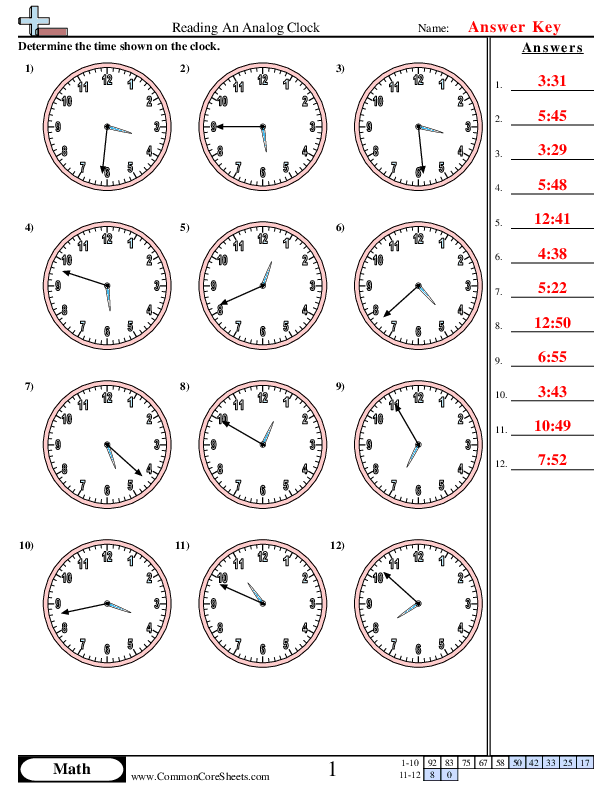
Reading a Clock (1 Minute Increments)


×
Description:
"This worksheet is designed to enhance children's understanding of reading analog clocks, an essential part of their math curriculum. With 12 varied problems, it fosters the practical application of time-telling skills. Its flexible format allows customization, conversion into flashcards for nimble learning, or use in distance learning environments. Ideal toolkit to make mastering time enjoyable and effective for young learners."

×
Student Goals:
Reading Time MasteryUpon successful completion of this worksheet, children should have mastered the fundamental skill of reading an analog clock. This includes understanding the placement of the hour and minute hands and how they represent time. Reading an analog clock is a classic essential skill that leads to a more profound temporal comprehension.Analog to Digital ConversionStudents will gain the ability to confidently and competently convert the time shown on an analog clock to a digital format. This conversion skill strengthens their digital literacy and ensure they are able to interpret and communicate time using both traditional and modern forms.Mathematical ProficiencyThis worksheet supports the development of children’s basic mathematical skills, such as addition and multiplication, through the act of calculating minutes and hours. It serves as an effective tool in illustrating the practical application of these mathematical operations in routine daily activities.Real-Time ApplicationsBy learning to read an analog clock, students can apply this knowledge to real-world situations. Whether it's determining the time for their favorite TV show, school bus schedule, or family activities, they can better manage their time and develop planning skills essential for personal and academic growth.Temporal AwarenessCompleting this worksheet will enhance students' temporal knowledge. They will learn about the concept of time, including seconds, minutes, and hours, and its passage. This will positively impact their ability to schedule events, estimate the duration of activities, and improve their overall time management.Problem-Solving SkillsWorking through the problems in this worksheet will foster improved problem-solving skills. As they engage in decoding the positions of clock hands, students will experience the process of resolving practical problems, thereby boosting critical thinking skills beneficial for many subjects and aspects of life.


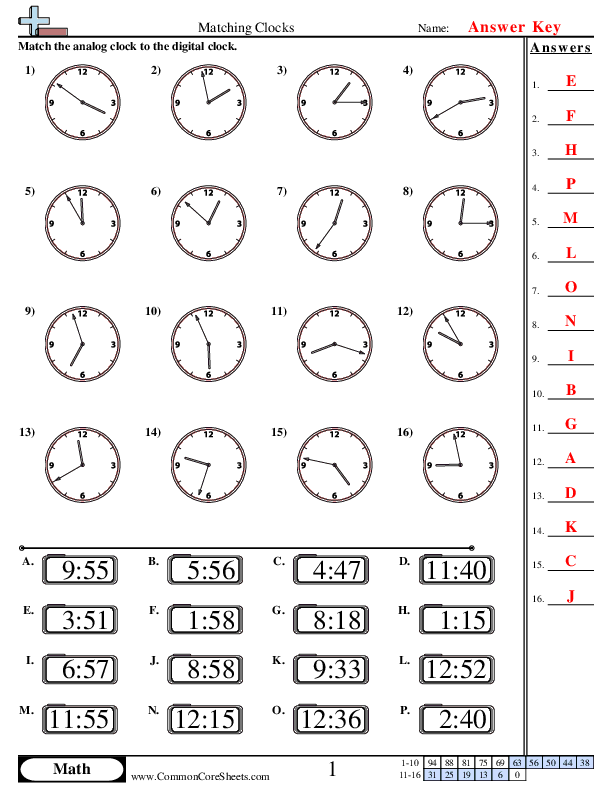
Matching Clocks (1 Minute Increments)


×
Description:
"This worksheet is designed to boost children's math skills through unique 'Matching Clocks' exercises featuring 16 problems. It encourages understanding of time-telling concepts in a fun and interactive way. The worksheet is customizable to cater to individual learning speeds and can be converted into flashcards for ease of use. Ideal for remote or distance learning, it adds versatility to every child's learning journey."

×
Student Goals:
Understanding TimeAfter completing this worksheet, students should have a stronger understanding of how to read time on analog and digital clocks. They should be able to comfortably tell and match the times represented on different types of clocks. This foundational ability is critical as the concept of time is a fundamental aspect of everyday life.Mathematical SkillsThe worksheet will enhance students' basic math skills as they will practice comparing and matching different times, which involves concepts of greater than, less than, or equal to. Furthermore, it helps in understanding the concept of time intervals which is a key component in arithmetic.Problem Solving and Analytical SkillsBy wrestling with different time-matching problems, students will learn to apply logical thinking, observational, and problem-solving skills. They will be confronted with varying problem scenarios which require keen analysis and a systematic approach to arrive at correct responses.Concentration and Attention to DetailThis worksheet will also help in improving the students' concentration levels. Dealing with the intricacies of matching clock times, noticing minute and hour hand positions, and ensuring correct matches requires and therefore fosters attention to detail.Confidence and AchievementLastly, the worksheet is designed to cultivate a sense of achievement and confidence in students. As they successfully solve the problems and match the correct times, they will feel accomplished. This progress can serve to motivate them further in their learning journey and grow their love for the subject of math.



Creating Clocks (1 Minute Increments)


×
Description:
"This worksheet is designed to enhance children's math skills, particularly time recognition, through a fun and interactive 'Creating Clocks' activity. Featuring nine problems with various times, it offers kids a way to effectively practice and understand the concept of time. Importantly, this worksheet can be versatilely customized, converted into flashcards for additional practice, or incorporated into distance learning platforms, making it an adaptable tool for diverse learning environments."

×
Student Goals:
Time UnderstandingStudents should develop a thorough understanding of how time is told and how to interpret it on analog and digital clocks. This skill is not just mathematical but practical, as it is used daily in multiple real-life contexts, such as understanding schedules and planning activities.Mathematical Skill EnhancementBy engaging with time-related problems, students hone their counting and arithmetic skills. Additionally, students learn about concepts like hours, minutes, and seconds, further broadening their competence in number systems and computations.Problem-Solving AbilitiesDealing with time-related problems encourages logical thinking, which can increase a student's problem-solving skills. As they determine the problems' solutions, they employ deductive reasoning and critical analysis, improving their analytical abilities in the process.Confidence and AutonomySuccessfully managing time-related tasks can boost a student's confidence in their mathematical skills. This self-assuredness can lead to an increased desire for independence, as they apply the skills learned to everyday situations, such as reading bus schedules or planning their day.Foundational Knowledge in TimeUnderstanding how to read a clock is a foundational skill that aids in learning more complex time-related concepts such as elapsed time, calculating the duration of events, and understanding timelines. Mastering these basics provide a strong foundation for more advanced mathematical lessons.Cognitive DevelopmentBy thinking critically to solve the problems in the worksheet, students stimulate and advance their cognitive development. This cognitive growth goes beyond academics, extending into daily life and personal growth.Time Management SkillsBy understanding the concept of time, students can gradually grasp the idea of time management. Recognizing the importance of time prepares them for a set of essential life skills such as punctuality, organization, and efficient planning.


Determining Starting Time
Link
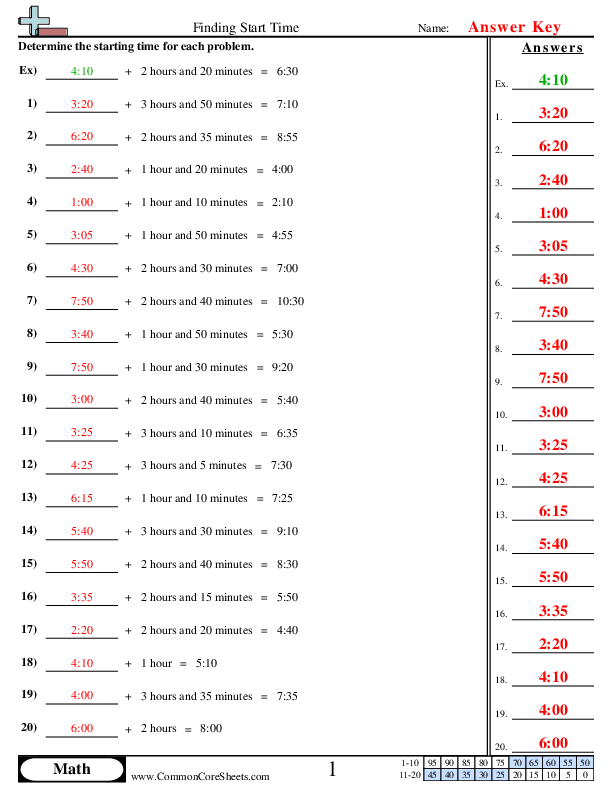
Time Only
3md1


×
Description:
"This worksheet is designed to enhance children's math skills, specifically in understanding and computing time. With 20 problems, students will work on calculating start times by adding hours and minutes. Tailored to suit individual learning needs, it can be customized and converted into flash cards for easier learning. It's ideal for distance learning, allowing students to practice time management problems independently."

×
Student Goals:
Enhanced Time Telling SkillsAfter completing the worksheet, students will have significantly improved their ability to tell time, a fundamental skill for daily life. They will be more conversant with reading the clock and interpreting the hours and minutes hands of an analog clock. Additionally, they will acquire proficiency in digital time representation, further contributing to their overall math competency.Improved Addition SkillsThis worksheet is also geared towards bettering students' addition skills. As they work through the problems, they will learn to efficiently add hours and minutes, ultimately achieving a seamless combination of the digital time format. This proficiency will not only apply to time-related calculations but also to other aspects of math where addition is fundamental.Boosted Mental Math CapabilitiesBy working through the problems in the worksheet, students will boost their mental math capabilities. The problems are designed to help the children practice and enhance quick addition of hours and minutes without needing to write down the process. This will aid in enhancing their critical thinking and mental calculation capabilities.Practical Real-World ApplicationThe worksheet aims at helping students be more comfortable with real-world math applications. By being able to calculate start and end times, students will find it easier to plan their schedules, a crucial aspect of time management. This understanding of time dynamics will make them more organized individuals in general.A Profound Understanding of Time DurationFinally, by attempting to solve the math problems given in the worksheet, students will have gained a profound understanding of time duration. They will get a clear sense of how much time has passed between different points of the day. This awareness can help them in areas such as project planning, understanding timelines, or even just monitoring their recreational screen time.


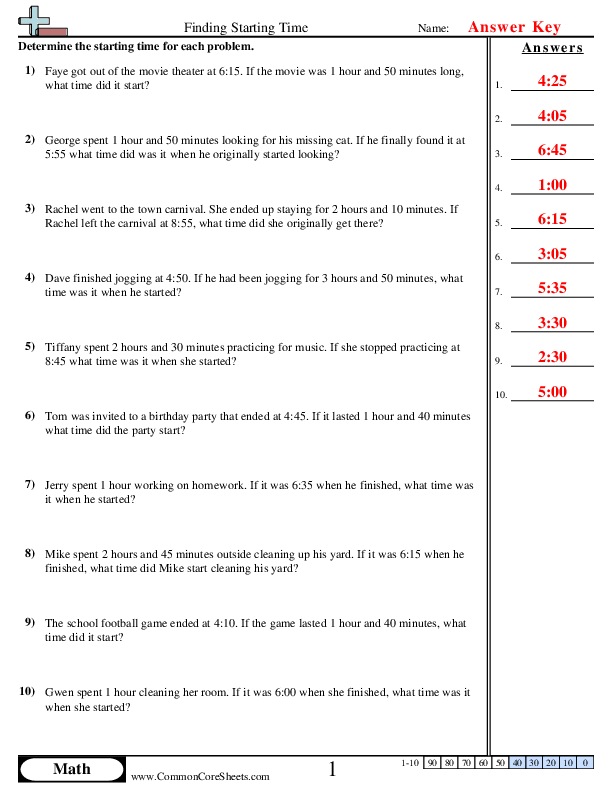
Word Problems
3md1


×
Description:
"This worksheet is designed to enhance children's understanding of time, through engaging problems focusing on calculating the start time of various activities. With 10 diverse problems, it offers an enjoyable way to learn and practice math. It can be completely customized to suit individual learning patterns and conveniently converted into flashcards for quick reviews. This worksheet is also a valuable resource for distance learning, facilitating one-on-one online sessions with ease."

×
Student Goals:
Understanding Time ManagementAfter completing this worksheet, students should have a firm understanding of how to manage time effectively. This involves calculating durations, estimating start and end times, and comprehending the concept of hours and minutes. They’ll be able to break down activities within a specified timeframe and calculate their durations, as well as predict start and end times of various activities.Application of Math SkillsThis worksheet applies the practical use of addition and subtraction of time in a real world context. Students will practice and improve their basic arithmetic skills, particularly with regard to time calculation. They will become adept at subtracting hours and minutes, reinforcing their overall mathematical aptitude and competence.Building Problem-Solving SkillsStudents will enhance their problem-solving skills as they learn to solve each time-related question. Understanding and calculating the start or end times of events is a great way to encourage logical thinking. These problems will stimulate their reasoning abilities and encourage them to develop effective strategies for solving similar problems in the future.Practical Time Management SkillsBy understanding how time works, students will be equipped with a practical life skill. They will be empowered to better organize their daily routines, thus enhancing their personal time management. Understanding durations and start/end times of activities are useful skills, not only academically but also for personal time management.Enhanced Comprehension SkillsThrough this worksheet, students will work on boosting their ability to comprehend and interpret problems accurately. They will improve their reading comprehension by interpreting the problems, and then applying mathematical skills to solve them. This skill is translatable to numerous other subject areas, reinforcing the general study and comprehension skills of the students.Confidence in NumeracyLastly, upon successfully finding starting times for various activities and events, students will build confidence in their numeracy abilities. This boosts their morale and builds a positive attitude towards mathematics and its practical applications, promoting a lifelong interest in the subject.


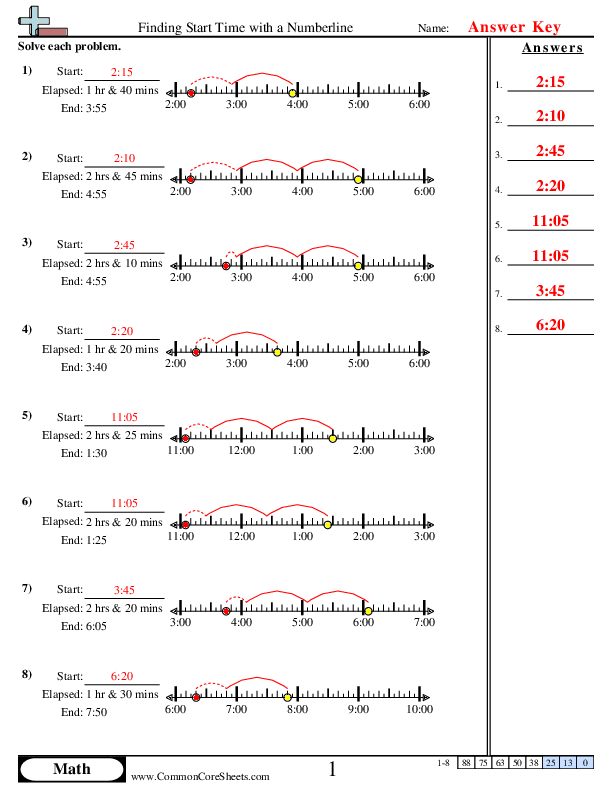
Finding Start Time with a Numberline


×
Description:
"This worksheet is designed to enhance children's understanding of time with the concept of a number line. It presents 8 engaging math problems that require calculating start times and elapsed durations. It offers flexibility, allowing customization, conversion into flash cards, or usage in distance learning for optimal reinforcement of time calculation skills."

×
Student Goals:
Grasp of Time ConceptsBy the end of this comprehensive worksheet, students should have a solid understanding of key time-related concepts. They should be able to adequately identify start times, estimate elapsed times, and determine end times. This foundational knowledge of how time works is crucial in day-to-day activities and planning.Improved Problem-solving SkillsCompleting this worksheet will help learners to improve their mathematical problem-solving skills. Students will have practiced deducing time differences and computing end times based on the start times and elapsed times. This experience will prepare them for more complex mathematical problems and promotes logical thinking.Understanding and Using Number LinesStudents should have the ability to correctly use a number line to visualize the span of time and make calculations easier. They should know how to plot times correctly on the line and use it to follow the flow of time. This understanding can then be applied to solving other time-related scenarios.Familiarity with Real World ApplicationThe practical examples in the worksheet help students see the real-world applications of abstract mathematical concepts. Through these exercises, they should understand how these principles apply in their lives, enhancing their appreciation of the subject.Increased AccuracyStudents ought to improve their accuracy when working with time. They will learn the importance of precision in time management and develop a keen sense of detail, which is necessary in tackling higher-level mathematical problems.Development of Time Management SkillsBy understanding elapsed time and how quickly time can pass, students will begin to develop time-management skills. They should understand the importance of maximizing their time and making every minute count in their academic and personal lives.


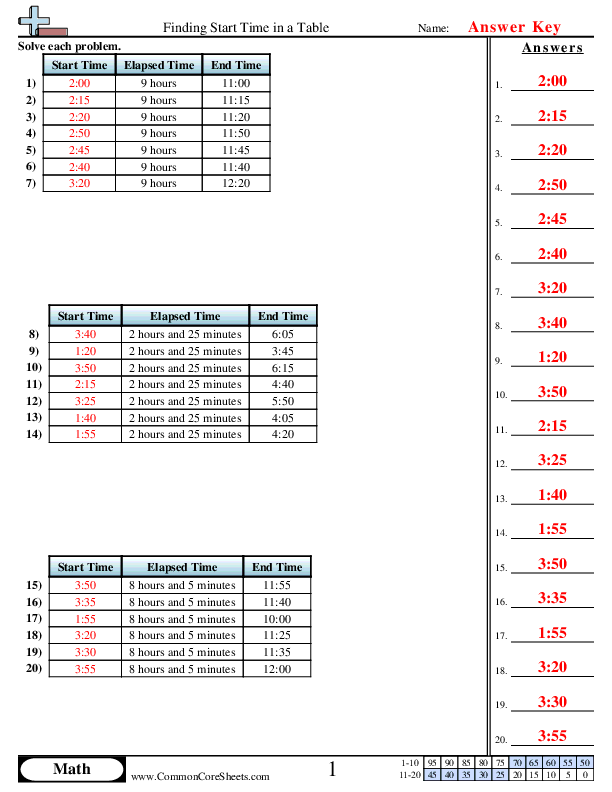
Finding Start Time in a Table


×
Description:
"This worksheet is designed to sharpen children's math skills specifically in the area of time. It contains 20 problems that challenge them to find the start time in a table, emphasizing on familiarizing kids with time calculation. Exceptionally versatile, it can be customized to match individual learning needs, transformed into flashcards for engaging practice, or integrated into distance learning programs."

×
Student Goals:
Time Telling MasteryUpon the completion of this worksheet, students should have developed a solid understanding of how to read and interpret time on both analog and digital clocks. Their ability to track the passage of time in various units such as hours, minutes, and seconds should have significantly improved. This basic math skill is crucial not only for future mathematical exploits, but also for day-to-day management of time.Reinforce Mathematical ConceptsIn utilizing this math-based worksheet, students will be enhancing their foundational mathematical skills. They would practice the concept of addition and subtraction with regard to time, further strengthening their arithmetic prowess and making it second nature to them. This grounding in math will be particularly useful as they advance to more complex mathematical concepts.Problem Solving and Critical ThinkingThe worksheet is strategically designed in such a way that students have to do more than just count numbers. It offers adaptive challenges that require students to think deeply and manipulate numbers in a guided setting. It will cultivate the skill of problem-solving and cultivate a mind adept at critical thinking. These skills are not only important for future academic attainment but also for navigating through life.Enhance Time ManagementBy gaining a deep understanding of the concept of time and how to calculate it, students are instinctively learning how to manage their time. Through the tasks in the worksheet, they indirectly learn the value of time, the importance of punctuality, and how to allocate time appropriately for various activities, a much-needed skill for their future.Boost ConfidenceFinally, by successfully completing the problems posed in the worksheet, students will experience a boost in their confidence. The acquired knowledge and skills will not only make them more comfortable tackling similar problems in the future but also do so with increased self-assuredness. This enhancement in confidence level can translate into improved overall academic performance.


Determining Elapsed Time
Link
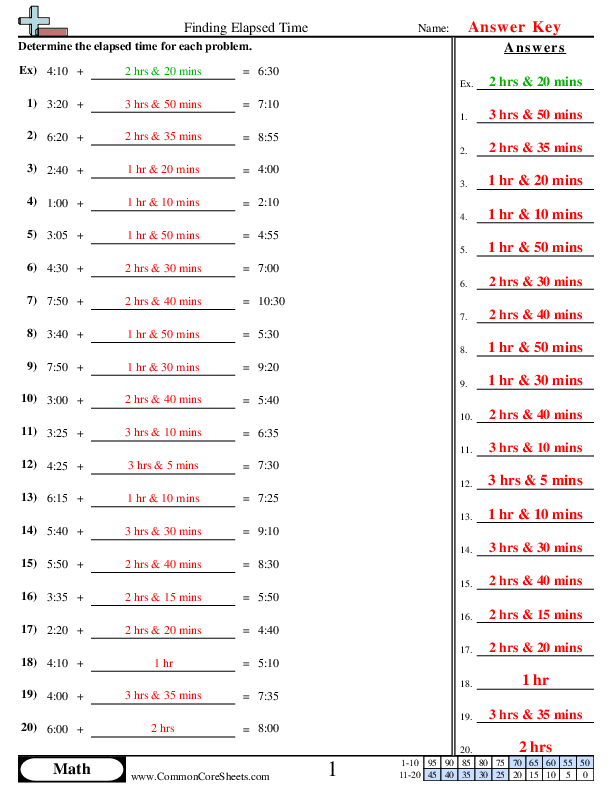
Time Only
3md1


×
Description:
"This worksheet is designed to help young learners practice and master the concept of finding elapsed time. With 20 engaging math problems, children can apply their time-reading and addition skills to solve real-world clock scenarios. Fully customizable, this versatile learning tool can be transformed into interactive flashcards or easily incorporated into distance learning modules for a diverse range of educational settings."

×
Student Goals:
Comprehend elapsed timeUpon completing this worksheet, students should have a solid understanding of what elapsed time means. They would grasp how to calculate the span of time that has passed between two specific moments, which is a vital life skill. Calculating elapsed time can aid students in a variety of real-world contexts, such as planning schedules, understanding durations of events, or even just watching the clock.Improve time calculation skillsWorking on these problems will significantly improve the students' ability to calculate time. They will become skilled at adding hours and minutes to a given time, building their mental math skills. This skill will prove beneficial not only in other advanced math problems where time calculation is necessary but also in day-to-day scenarios like estimating completion time for tasks.Enhance problem-solving capabilitiesStudents should also see an enhancement in their overall problem-solving capabilities. The problems leverage a mathematical approach to improve logical thinking and strategizing. This improvement is beneficial for cognitive development, equipping students with the analytical abilities needed to solve complex problems.Inculcate punctuality and time managementIn working through these problems, students will intuitively learn the importance of time management and the concept of punctuality. Understanding how time intervals work is a big step towards better organization, planning, and productivity.Promote practical application of mathAt the end of this worksheet, children will grasp how math is not a remote academic subject but applicable in daily situations. The relevance of mathematics to practical usage is stressed, lending a fun, relevant angle to learning and encouraging students to explore further fields where math principles are employed.


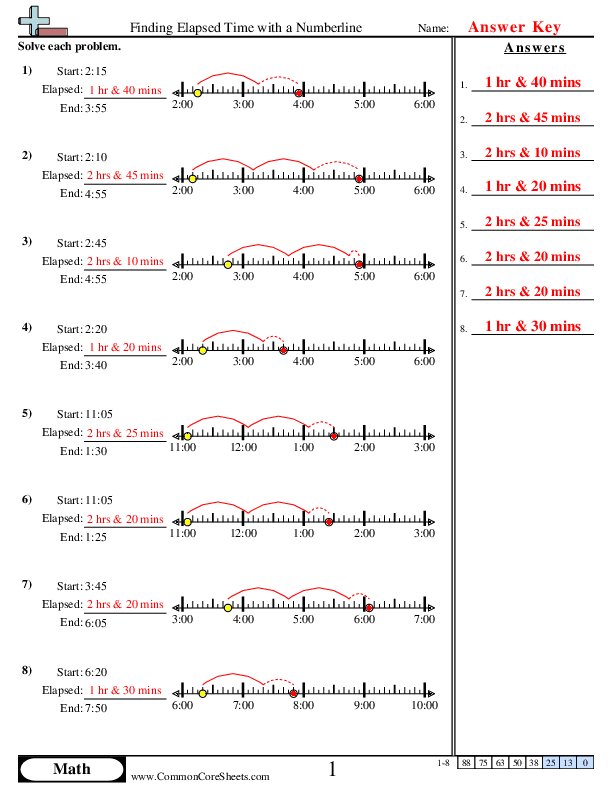
Finding Elapsed Time with a Numberline


×
Description:
This worksheet is designed to enhance children's understanding of elapsed time through the use of a numberline. It includes eight unique math problems, each challenging students to calculate start and end times. This engaging and interactive approach can be customized to suit individual learning goals, converted into flashcards for quick revision, or easily integrated into a distance learning curriculum. An ideal tool to make mastering time calculations both fun and effective for your child.

×
Student Goals:
Time Calculation MasteryAfter completing this worksheet, students should have gained mastery in the calculation of elapsed time using a numberline. This exercise helps build real-life skills as time management, understanding of time intervals, planning, and scheduling are founding on this same concept of elapsed time.Problem Solving SkillsIn addition to mastering elapsed time, students will have enhanced their problem-solving skills. They will have learned how to approach a problem, break it down into simple manageable parts, find solutions, and finally verify whether the findings are correct. These skills are not only applicable in mathematics but in life situations as well.Independent LearningThe worksheet promotes independent learning as students maneuver through the problems on their own. It helps to instill patience, resilience, and perseverance in students as they strive to solve each problem, thereby fostering a sense of self-reliance and autonomy.Improved Number SenseHandling time-related problems improves number sense - the ability to use numbers and mathematical processes efficiently and flexibly. By working through these problems, students will improve their comfort level with numbers, aiding them in tackling complex mathematical problems in future.Enhanced Attention to DetailPrecision is key when calculating elapsed time. Therefore, students completing this worksheet will have an improved attention to detail. This, in turn, reduces the chances of making errors in their calculations.Familiarity with the ClockStudents will become more familiar with the clock and the concept of time. They will understand the structure of the day and how time is segmented.


Determining Ending Time
Link
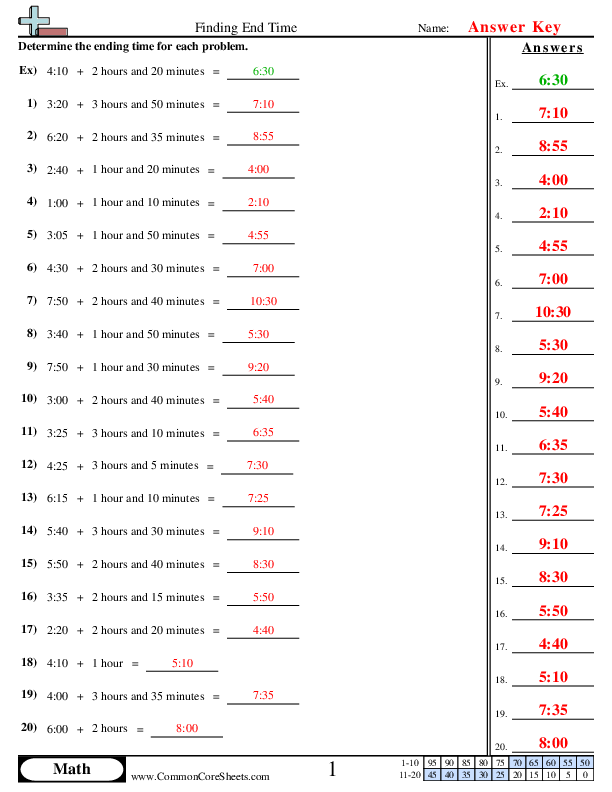
Time Only
3md1


×
Description:
"This worksheet is designed to enhance children’s time calculation skills in a fun and engaging manner. Central to the theme 'Finding End Time', it contains 20 math problems that guide learners to find the end time after adding an interval to a starting time. It can be customized to fit different learning styles, being easily converted into flashcards, used for distance learning, or in traditional classroom settings. It's an efficient method of reinforcing concept applications in time."

×
Student Goals:
Master Time CalculationsUpon completion of the worksheet, students should have developed a comprehensive understanding of how to calculate end times. This worksheet focuses on adding hours and minutes to an initial time, allowing students to master the concept of telling time and calculating elapsed time. Through the different time calculation exercises, students will have enhanced their skills in basic arithmetic, specifically in the area of addition involving hours and minutes.Develop Problem Solving SkillsAs students navigate through the worksheet, they should have honed vital problem-solving skills. Every problem they tackle enables them to engage their mental faculties to find solutions. This process promotes cognitive development and enhances their abilities to approach, analyse, and solve problems. This worksheet would have therefore succeeded in fostering students' critical thinking and analytical skills.Improving Precision and AccuracyTime calculations require a high level of precision and accuracy, making it an excellent way to develop these skills. After successfully completing this worksheet, students would have gained experience in ensuring accuracy in their calculations. This practice not only helps with time-related problems but also significantly contributes to the precision needed in various mathematical operations and real-life scenarios where accurate calculations are imperative.Boost Time Management SkillsCompleting these exercises will give students an initial understanding of the concept of duration and time management. They will learn to calculate how much time has passed, giving them a head start in learning how to organise, plan, and manage their time effectively. Thus, aiding in preparing them for more complex scheduling tasks in the future.Enhance Conceptual Understanding and ApplicationBy the end of this worksheet, students should be able to apply their understanding of time in real-life contexts. The problems posed in the exercises mimic scenarios one may encounter daily, thereby allowing students to better conceptualise and apply their knowledge and skills. It is expected that they can accurately estimate the time of an ending event given a starting time and duration, hence becoming more adept at time management in practical situations.


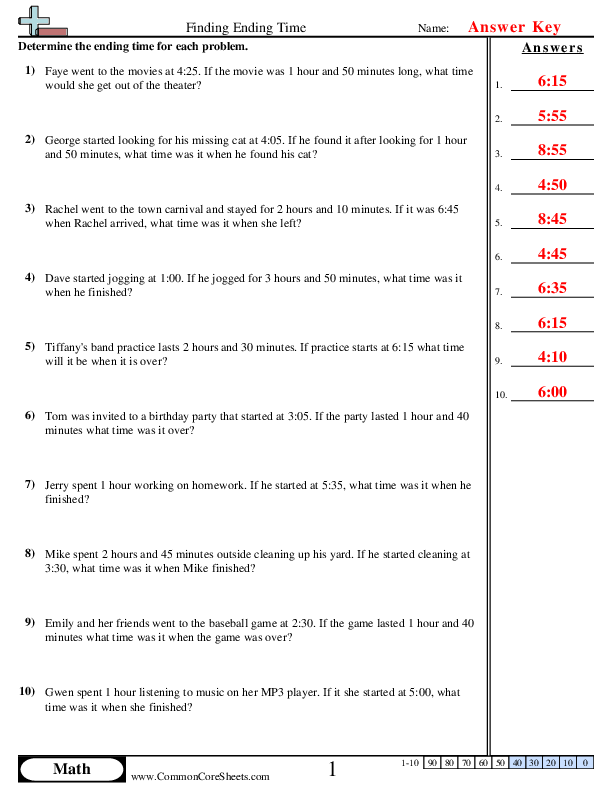
Word Problems
3md1


×
Description:
"This worksheet is designed to aid children's understanding of math, specifically focusing on calculating ending time. With ten customizable problems, it helps children apply basic skills in real-life scenarios such as cooking, homework, and extracurricular activities. Suitable for distance learning, it can also be converted into flash cards for interactive and engaging study."

×
Student Goals:
Understanding of Time IntervalsAfter completing the worksheet, students will develop a much stronger grasp of how time intervals work, understanding the duration between two specific points in time. This understanding will have a real-world relevance in many day to day scenarios, helping students become punctual and disciplined.Enhanced Mathematical AbilityAs the worksheet focuses on arithmetic related to time calculations, students will enhance their mathematical abilities by practising addition and potentially, subtraction involving hours and minutes. This will also give them a clearer understanding of the concept of 'elapsed time' within the context of daily activities.Improved Problem Solving SkillsBy navigating through practical real-world problems about daily activities, students will improve their problem-solving skills. Each problem has a unique scenario that encourages students to actively engage their problem-solving abilities, leading to an overall enhancement of critical thinking skills.Increment in Reading ComprehensionSince questions are set in a story-like format, students will have an incremental increase in their reading comprehension skills. They will learn how to extract relevant information from a given context which is a highly useful skill in all areas of learning.Practical Application of LearningFinally, these tasks will help students understand the practical applications of their learning. They will realise that complex mathematical concepts are not just textbook theories but have tangible, everyday uses. This will help students appreciate learning as something that goes beyond academic achievement, playing a pivotal role in their day-to-day lives.


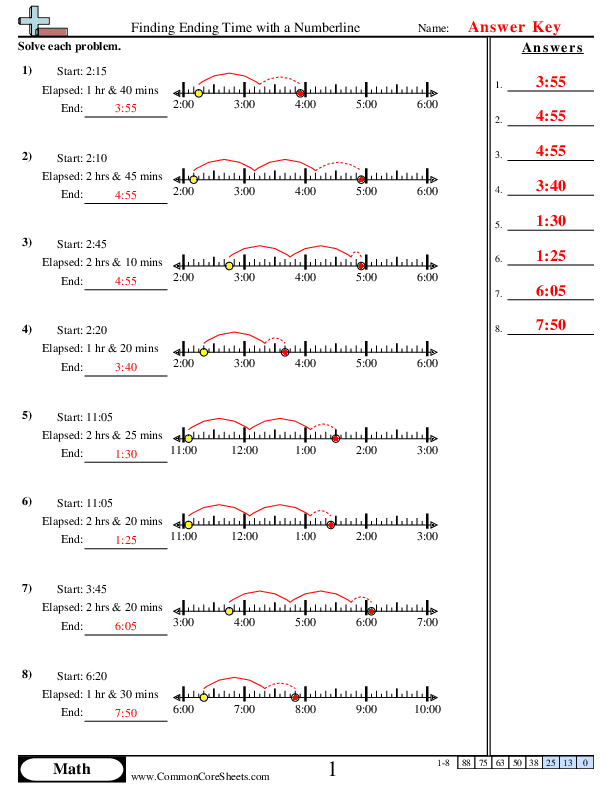
Finding Ending Time with a Numberline


×
Description:
"This worksheet is designed to enhance children's understanding of mathematical concepts related to time measurement. Through eight engaging problems, students learn to calculate end times on a number line, thus fortifying their mental arithmetic skills. Highly customizable, this tool can be converted into interactive flash cards or be incorporated seamlessly into distance learning modules, offering flexibility in teaching methodologies, and driving student involvement & growth."

×
Student Goals:
Understanding Time ConceptsUpon completion of this worksheet, students should be able to understand and use time-related concepts more effectively. They can figure out the relationship between hours and minutes, especially how these units of time can add up to represent a particular period. Understanding what elapsed time is and how to calculate it in a practical context is a also a key competency that will be developed by working through this exercise.Developing Mathematical ProficiencySolving the problems in this worksheet can significantly enhance the students' mathematical proficiency. They will cultivate the ability to apply their knowledge of addition and subtraction to find the ending time, which can prove useful in real-world situations. They will learn how to incorporate a number line into finding solutions, developing ability to relate abstract mathematical concepts to graphical representation.Improving Problem-Solving SkillsThis worksheet is designed to improve students' ability to logically approach and solve problems. They will be challenged to utilize their mental math skills and apply them practically, transforming the abstract idea of time into tangible numbers to work with. It could help with their ability to think critically, reason logically, and come up with viable solutions to the problems presented.Enhancing Application of KnowledgeBy completing this worksheet, students are encouraged to apply their theoretical understanding to realistic scenarios. The process of deducing the end time from the given start time and elapsed duration is a practical skill that could prove useful in many everyday situations, such as timing activities or predicting finishing times. This reinforces the relevance and application of their classroom learning to real-world contexts.Building Confidence with NumbersThis engaging math worksheet can boost students' confidence in dealing with numbers, as they successfully solve problems involving time and durations. This confidence can stimulate them to explore more complex mathematical calculations and equations. This acquired self-assurance can aid them not only in math, but also in other subjects where numerical understanding is required.


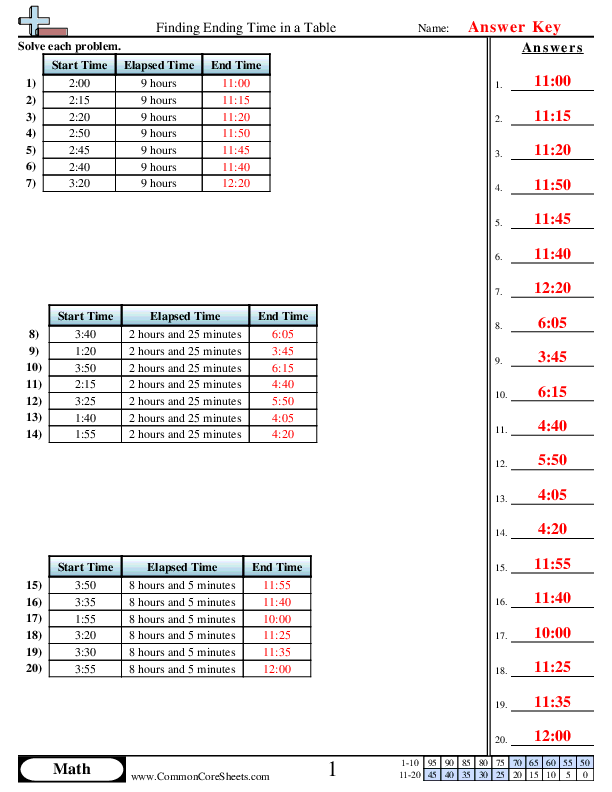
Finding Ending Time in a Table


×
Description:
"This worksheet is designed to enhance children's understanding of time calculation in mathematics. It features 20 problems where the goal is to find the ending time given starting times and durations. The exercises help in solidifying crucial time-related concepts. It can be customized to fit individual learning styles and converted into flash cards, making it a versatile tool perfect for distance learning."

×
Student Goals:
Understanding of Time TablesAfter successfully completing the worksheet, students are expected to gain a robust understanding of how to determine the ending time from given start times and durations. They would have practiced this concept with various start times and durations, thus improving their familiarity and flexibility with time calculation methods. The critical ability to quantify time passage using real-world examples, such as given in the timetable, is an important mathematical and life skill.Time Addition and Basic MathematicsThe worksheet also improves the students' prowess in basic addition and subtraction, with its constant demand to perform mathematical operations involving time. Time, in this case, adds an extra layer of complexity given the non-decimal nature of the counting system. This practice will also solidify their understanding of the clock system where hours are divided into 60 minutes.Problem Solving & Analytical SkillsWorking on these types of problems increases the students' problem-solving capabilities and boosts their analytical thinking. Looking at the given start time and the time duration, and then figuring out the ending time, builds their logical reasoning skills. By regularly solving these problems, students would intuitively understand the relationships between hours and minutes and be able to quickly convert between the two.Understanding Real-World Time-Based ScenariosThe worksheet further educates students on how to manage time in real-world situations. It prepares them for situations where they will have to calculate the ending time of an event given the starting time and its duration. As they grow, this ability to estimate time periods assists in managing their personal and professional schedules, planning travel itineraries, and more.Building ConfidenceFinally, with the successful completion of this worksheet, students should feel a boost in their confidence. The accomplishment of solving problems and understanding concepts independently tends to enhance their academic self-esteem. Additionally, their progress in these worksheets could foster a positive learning attitude and excitement towards the subject of mathematics itself.


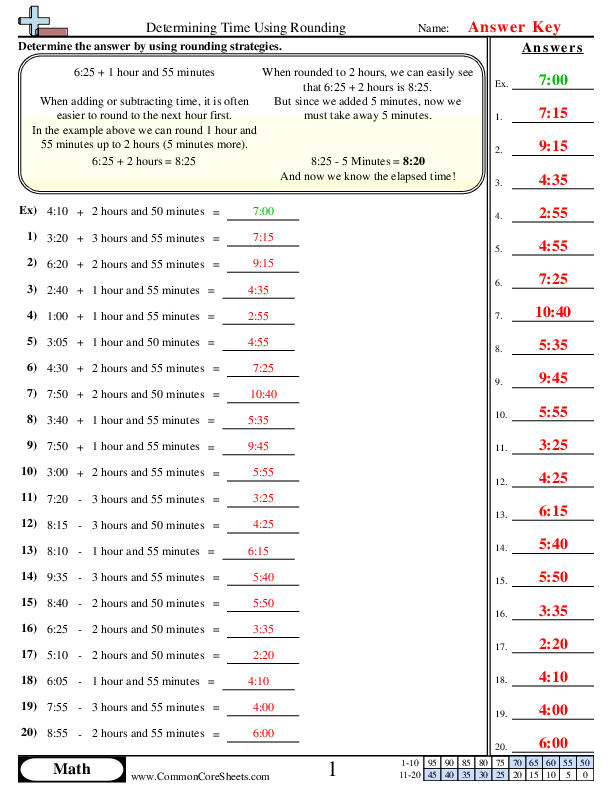
Determining Time (Using Rounding)
3md1


×
Description:
"This worksheet is designed to improve children's math skills, specifically in determining time using rounding. The sheet includes 20 problems featuring various time additions which challenge learners to improve their understanding of time structure. This customizable material can be converted into flash cards, making it a versatile tool for in-person or distance learning environments that can be tailored to individual student needs."

×
Student Goals:
Understanding Time ConceptsAfter completing the worksheet, students should have a solid understanding of time concepts. They will be adept at reading time and have a better grasp of how hours and minutes are accumulated to form a whole day. Understanding the value of time and how it operates is a critical skill that will not only aid their mathematics studies but also their daily life. They will be able to schedule their daily activities more effectively by understanding how time adds up.Rounding SkillsThe worksheet will significantly improve students’ rounding skills. Rounding is a crucial concept in mathematics and other subjects that involve computations. It helps simplify numbers to make them easier to comprehend and operate on. Students will, therefore, gain an understanding of the importance of rounding in approximating numbers, specifically in the context of time management. They will be more capable of estimating and interpreting time durations following the completion of the worksheet.Ability to Calculate Time DifferencesUpon completing this worksheet, students should have developed the ability to calculate differences in time. This is a valuable and practical skill that can be translated into real-life situations like computing travel time, duration of events, or calculating project timelines. It will aid students not only in their math curriculum but also in daily situations that require scheduling, planning, and understanding the relationship between durations of time.Improvement in Mental MathStudents will also boost their mental math skills after going through the given problems. The worksheet offers a fun and practical way for students to exercise their mind and enhance their calculation speed and accuracy. Since most questions require mental computation, students will get to flex their brain muscles and this, in turn, solidifies their numerical fluency.Problem Solving and Logical Thinking SkillsThe worksheet enhances students' problem-solving and logical thinking skills. By determining time using rounding, learners will be challenged to use their critical thinking abilities and analytical skills. This cognitive development will not only benefit their math capabilities but will also be useful in other areas, as problem-solving and logical thinking are universally applicable skills.


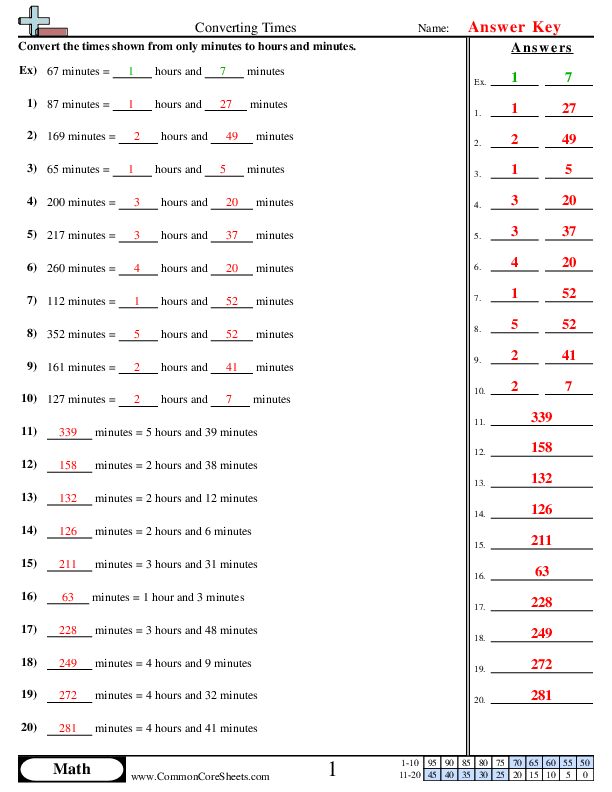
Converting Times
3md1


×
Description:
"This worksheet is designed to facilitate math learning by relating minutes to hours. The title, 'Converting Times', covers 20 problems aiming at improving students' numerical conversion skills. Problems range from converting 75 to 346 minutes into hours and minutes, ideal for establishing a solid understanding of time. The customizable nature allows for adaptability to various teaching methods like flash cards or distance learning platforms."

×
Student Goals:
Develop Mathematical ProficiencyAfter completing the worksheet, students should have developed proficiency in mathematical concepts, particularly in time conversion. This includes translating figures from minutes to hours and vice versa, a basic but crucial aspect of time comprehension.Master Time Management SkillsThe ability to convert time is not only a pure academic exercise but also a skill that is useful for time management. By mastering conversion between hours and minutes, students can apply this knowledge in scheduling their tasks and activities, enhancing their ability to manage time more efficiently.Enhance Problem-Solving SkillsSolving mathematical problems involves critical thinking and problem-solving skills. Each problem in the worksheet requires students to decipher and understand the question, use appropriate strategies to solve the problem, and verify their answers. Therefore, completion implies improved problem-solving capabilities.Foundation for Advanced Time ConceptsAs students master the simple concept of time conversions, they are laying a solid foundation for more advanced mathematical concepts related to time. This includes calculating elapsed time or determining differences in time zones, all of which are necessary for further mathematical studies and real-life applications.Improvement in Reading and Interpreting Numerical DataBy working on the worksheet questions, students are also practicing their ability to read and interpret numerical data. Through the repetition of similar problems with varying numbers, students are enhancing their quick response capability and improving their ability to interpret different visual forms of data.Confidence in Mathematical AbilitiesFinally, by successfully completing the worksheet, students gain confidence in their ability to solve mathematical problems. This is an important step in creating a positive attitude towards learning and achieving in mathematics or other numeracy-rich subjects.


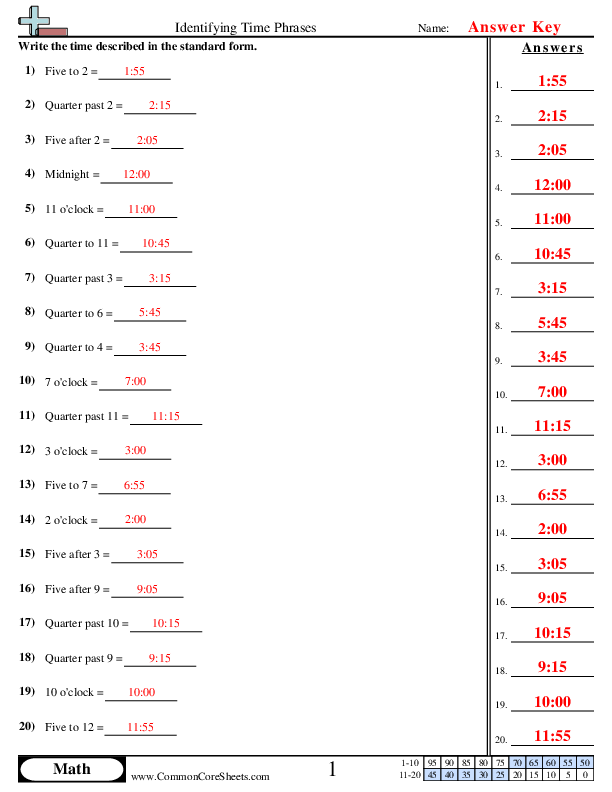
Identifying Time Phrases


×
Description:
"This worksheet is designed to help children identify and comprehend time phrases. Covering 20 problems on a math-based subject, it focuses on interpreting phrases related to clock readings such as 'Five after 4' or 'Quarter to 11'. Customizable for different learning approaches, it can be transformed into flash cards or used effectively in distance learning scenarios to enhance children's understanding of time concepts. It serves as an engaging tool to reinforce time telling skills."

×
Student Goals:
Understanding Time ConversionsBy successfully completing this worksheet, students should develop a solid understanding of time phrases and how to convert them into digital format. They should master recognizing and interpreting phrases such as 'quarter to', 'quarter past', 'five after', and 'five to' pertaining to the standard clock. This skill is essential in everyday life, and also sets a foundation for further studies in time management and scheduling.Mathematical Reasoning EnhancementThe process of converting time phrases into the corresponding numerical values will improve the student's mathematical reasoning skills. The task requires logical thinking and an understanding of how the standard clock works. This experience will help build their numerical and logical problem-solving abilities, which are important aspects of both their academic and personal life.Increase in Precision and Attention to DetailWorking on this worksheet will foster increased precision and attention to detail in students. Managing time measurements, even at a minute level like 'five after' or 'five to', requires a great deal of accuracy. Therefore, this task will promote meticulousness among students and help them learn the importance of precision in the field of math and beyond.Conceptual Understanding of TimeThe worksheet will help students to establish a conceptual understanding of time. Through the process of converting time phrases into their digital format, students will reinforce their understanding of the system of hours and minutes and how they relate. This understanding is crucial for other concepts like scheduling and time management.Development of Independent Problem-Solving SkillsStudents will develop the ability to independently solve problems. The worksheet trains the students to manage problems by themselves, thus, nurturing their ability to make decisions, apply strategies, and verify solutions. These skills are important for enhancing a student's self-reliance and confidence.


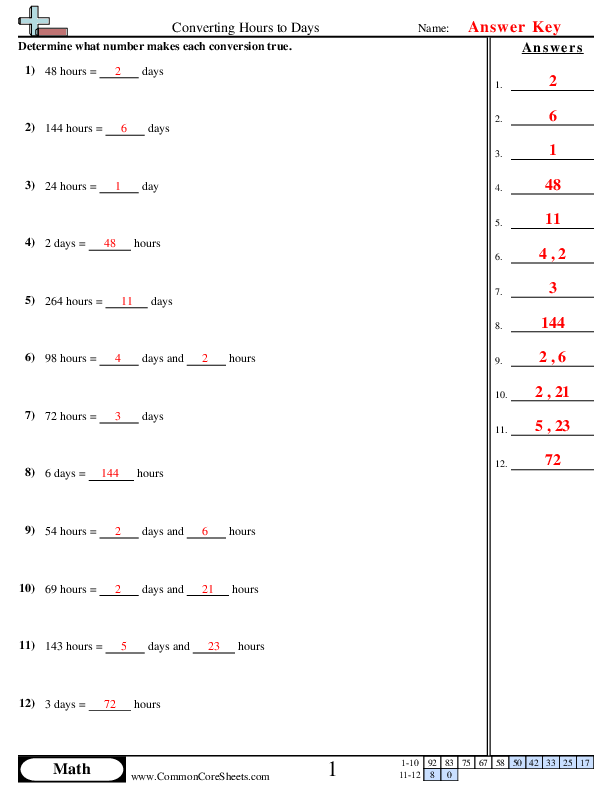
Converting Hours to Days


×
Description:
"This worksheet is designed to enhance children's understanding of time conversion, specifically from hours to days. It offers 12 math problems that exhibit different conversion scenarios, promoting hands-on learning and the application of mathematical concepts. Suitable for distance learning, this adaptable resource can be customized to varying difficulty levels or converted into flash cards for engaging, interactive education."

×
Student Goals:
Understanding Time ConversionUpon completing the worksheet, students will have a firm grasp on the concept of converting time between hours and days. This knowledge goes beyond merely academic knowledge, as this understanding has practical uses in everyday life. It aids in better time management and planning of activities, contributes to their development of logical reasoning and enhances their problem-solving skills.Enhanced Mathematical Tasks Solving SkillsBy completing the twelve problems in the worksheet, students will be able to enhance their mathematical skills. It gives them an opportunity to practice a variety of problems which helps them to understand how to apply appropriate methods at the right time to solve problems correctly. As they gradually solve problems, they will be able to gain confidence in their ability to handle similar mathematical tasks.Practical Application of Multiplication and DivisionIn solving the problems on this worksheet, students will have effectively applied multiplication and division skills to convert hours to days and vice versa. This reinforcing process is valuable for ensuring that students are able to correctly use these two fundamental mathematical operations in a practical, real-world sense.Decision Making SkillsSolving problems in the worksheet will enhance the decision-making skills of the students. They learn to analyze problems and make decision whether to multiply or divide to achieve a correct result. This practice eventually helps them to make efficient decisions in complex problem-solving scenarios.Accuracy and Precision DevelopmentWhile working on the worksheet, students learn the importance of precision and accuracy. The mathematical computations involved in the conversion of days to hours and vice versa require paying attention to small details, promoting the development of these important skills which are transferable to many other subject areas and life scenarios.Cognitive DevelopmentSolving the problems will challenge the students mentally, thereby improving their cognitive abilities. It broadens their thought processes and improves their analytical thinking ability. This will not only aid them in mastering the conversion of hours to days but also develop their overall cognitive abilities which are essential for other complex problem solving tasks.


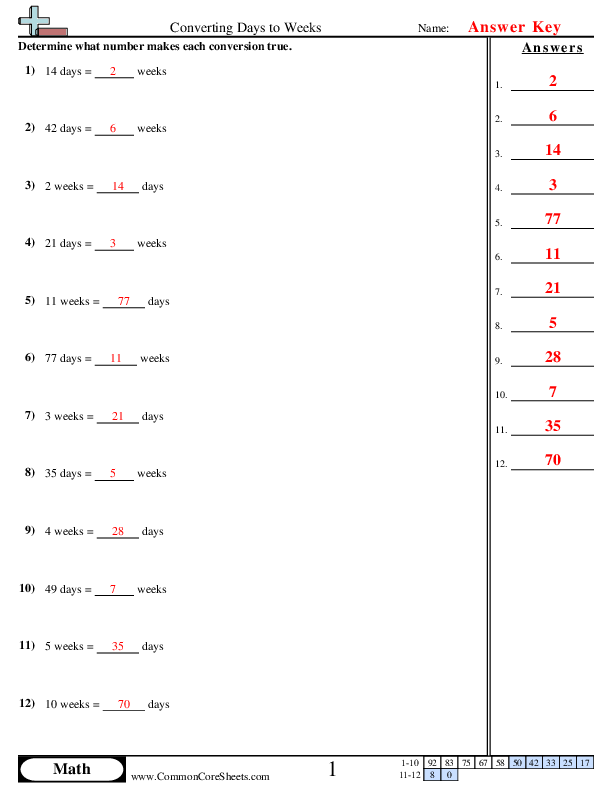
Converting Days to Weeks


×
Description:
"This worksheet is designed to bolster math proficiency by teaching kids how to convert days to weeks, and vice versa. With twelve interactive exercises, children engage with core concepts of time in a fun, hands-on way. It's highly adaptable, ideal for use in distance learning, and can be customized into flash cards for additional practice. By mastering these routines, children acquire a key skill that helps them understand and appreciate time's role in our lives."

×
Student Goals:
Gain Full UnderstandingAfter completing this worksheet, students should have developed a complete understanding of converting units of time between days and weeks. This is a fundamental skill in mathematics and is necessary for many practical situations, such as scheduling and time management.Apply Mathematical ConceptsStudents should be able to correctly apply the mathematical concepts in practical scenarios. The worksheet exposes learners to different problems, allowing them to explore different ways of applying the same concept. This practical exposure is beneficial for students, enabling them to understand how mathematical concepts are used in everyday life.Boost Problem-Solving SkillsWith the diverse set of problems in the worksheet, students will have their problem-solving skills challenged and sharpened. This worksheet is not only a measure of their current understanding but also a means to improve their strategic thinking ability. By solving these problems, they can improve their critical thinking and logical reasoning skills.Improve Speed and EfficiencyBy practicing the conversion between days and weeks repeatedly, students should see a significant improvement in their calculation speed and efficiency. Regular practice promotes speed, accuracy and it also aids in the mental memory of key conversion factors.Preparation for Advanced ConceptsThis worksheet may serve as a foundation for learning about more complex units of time further in their education, such as leap years, fortnights, etc. It would be a starting step for more complex calculations involving weekends, hours, and even seconds.Verification of CalculationLearners should be able to confidently check the correctness of their calculations. The problems offered in this worksheet require a solid understanding of both multiplication and division. This supportive learning tool allows students to examine their working methods and learn how to self-correct their mistakes.Increase in ConfidenceAs a final accomplishment, successfully working through these exercises should result in an increased confidence in handling mathematical problems. With regular practice of similar tasks, children can develop the habit of not hesitating or fearing errors, but viewing them as an opportunity to learn.


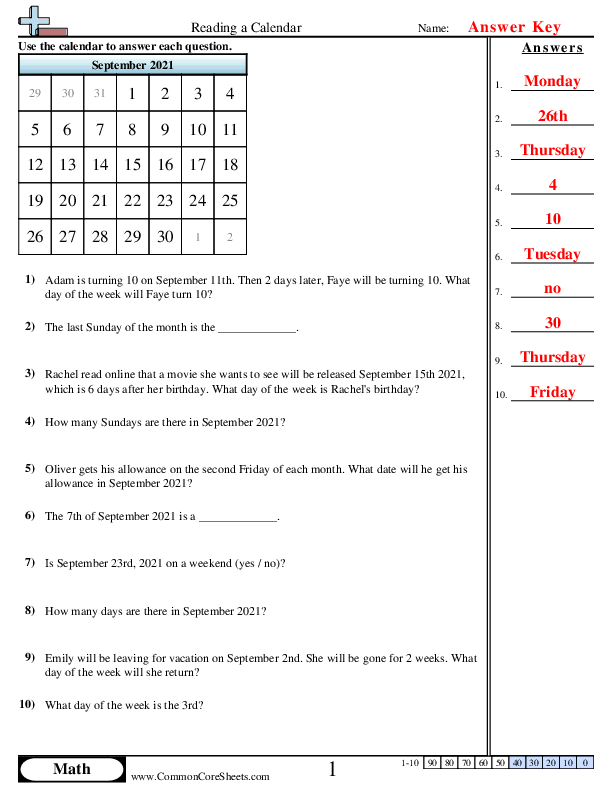
Reading a Calender


×
Description:
"This worksheet is designed to improve children's mathematical and chronological thinking. The 10-problem sheet titled 'Reading a Calendar' teaches concepts related to calendar reading, like identifying weekdays, counting days, and understanding sequence of events. Malleable and adaptable, this worksheet can be customized, transformed into flashcards for a handy learning tool or utilized optimally in distance learning environments."

×
Student Goals:
Understanding Dates and WeekdaysUpon successful completion of this worksheet, students will be able to accurately determine the day of the week for specific dates, enhancing their understanding of the calendar system. This will allow them to effectively plan and prepare for upcoming events, tasks, or activities.Developing Problem-Solving SkillsBy solving different math problems related to calendars, students will be able to enhance their problem-solving skills. These challenges require them to dissect numerical data related to days, dates, weeks, and months, critique it thoughtfully, and employ mathematical operations to come up with correct answers.Efficient Time ManagementStudents will learn how to calculate the number of days between two dates or from a specified time in the future. This will aid in developing time management skills and make them conscious of the passing of time and the importance of making every day count.Understanding Time-Based ConceptsThis worksheet will also enhance students' understanding of time-based concepts such as weeks, days, months, and how they relate to each. This understanding is crucial in daily life, ranging from knowing when holidays or birthdays are to determining when assignments are due.Improving Mathematical SkillsAs this worksheet incorporates math-based problems related to the calendar, it will also help in improving students' mathematical skills. The application of numbers, counting, and simple mathematical principles in a practical context makes it a valuable tool for sharpening numeracy skills.Building ConfidenceBy successfully determining answers for each problem, students' confidence will be boosted. This confidence can further produce stronger academic performance as students feel competent and motivated to tackle more advanced tasks.


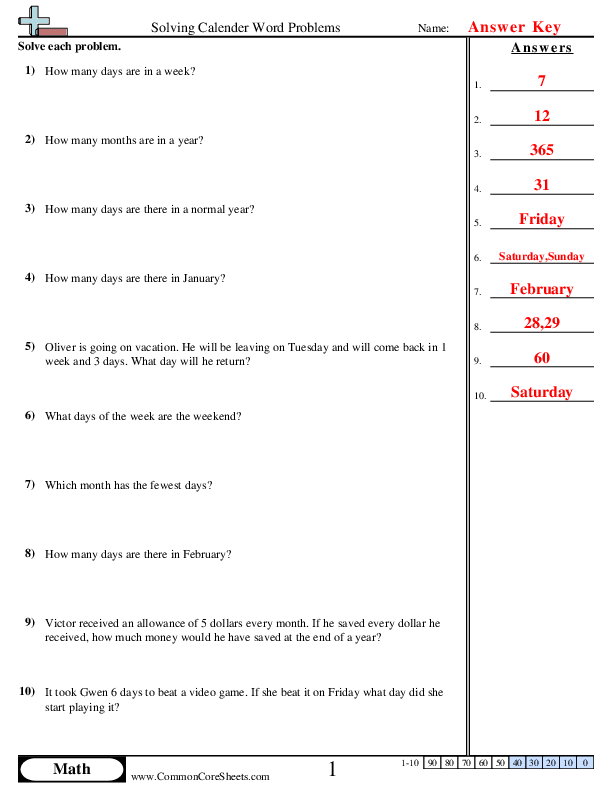
Solving Calender Word Problems


×
Description:
"This worksheet is designed to enhance children's math skills through 10 engaging calendar word problems. Concepts covered include calculating timelines, understanding weekly and monthly cycles, and identifying specific days. Perfect for customization and conversion to flashcards, it's also well-suited for distance learning settings, offering an interactive way to bolster numerical acumen and calendar comprehension."

×
Student Goals:
Basic Calendar ComprehensionAfter completing this worksheet, students should have a solid understanding of the structure and function of a calendar. They should be able to identify the days of the week, the number of days in each month, and the total number of days in a year. This comprehension serves as a foundational skill in their academic journey, aiding future tasks related to planning, organization, and time management.Time Calculation ProficiencyStudents will accomplish the ability to calculate the passage of time in different scenarios. They must grasp the concept of durations such as weeks, months, and years, and effectively apply these to real-world contexts. Whether it is determining the amount of money saved over a period, estimating the return date from a vacation, or calculating game completion times, students will develop a practical skill set for time calculation.Application of Mathematical ConceptsThis worksheet will aid students in applying their knowledge of addition and multiplication indirectly through word problems. The skill to visualize and execute mathematical operations using text-based problems is crucial for their problem-solving capabilities in the future. Relating dollar amounts to periods or deducing start and end days integrates math problems into daily life scenarios.Problem-Solving SkillsUpon completing this worksheet, students should have honed their ability to solve word problems. By translating real-life examples into numerical data and using their knowledge of calendars, they can find solutions to practical problems. This fosters their logical thinking, reading comprehension, and analytical thought process, which are integral for their overall scholastic and future career success.Calendar ReadingStudents should be confident in reading a calendar accurately upon completion of the worksheet. They should be able to navigate around months, weeks, and days and further identify special cases such as leap years or the unique case of February. By mastering these elements, students will have developed the proficiency to plan and manage their time better both in academia and in their daily lives.






